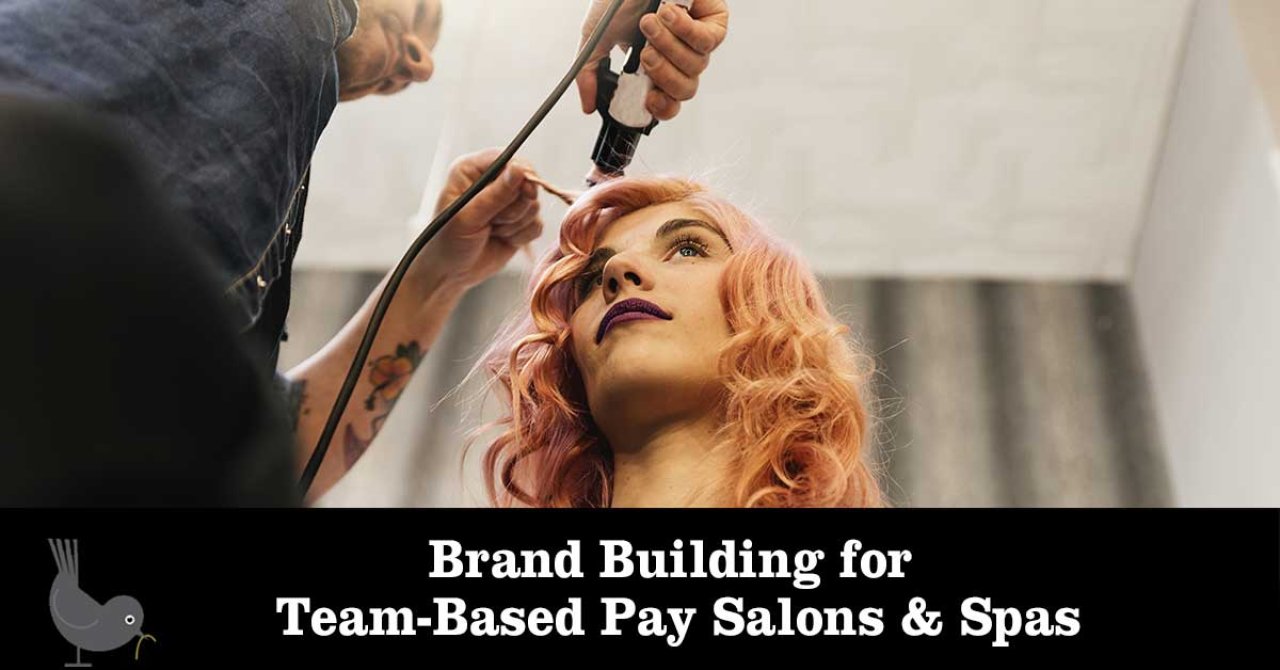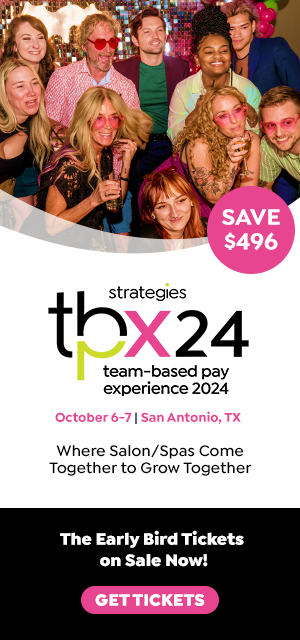Brand Building for Team-Based Pay Salons & Spas

Being busy doesn't create a brand.
Filling chairs and treatment rooms doesn't build a brand.
Building client loyalty to "stylists/estheticians/massage tech/etc." is more anti-brand building than anything.
There are amazing ways to "build" career opportunities for service providers far beyond "building their book."
Building a brand means building a "company" that delivers something unique and special to its customers that competitors just can't match.
Here are TWO significant brand-building strategies for salons and spas that fit perfectly into the Team-Based Pay Business Model:
Strategy #1: Sell "TIME" … not "services"
Your salon/spa sells time in exchange for your professional services. The old business model is about filling up individual service providers' columns on the appointment book with haircuts, color, skin care, etc. A "seize the moment" business model could easily be about selling clients blocks of time to receive multiple services and professional guidance from a team.
Here's an overview of what "selling time" versus services looks like:
To accomplish this, you need to know and understand your salon/spa's "Cost per Service Hour". Next, add your desired profit margin to arrive at your selling price per hour.
Here's a very simplified example:
- Divide your total three- or six-month total average "Cost of Sales" and "General & Administrative" expenses (less retail product cost) by the average service hours sold for those three or six months. That's your "service cost per hour".
- Then, add a profit margin of 25%.
- It would look like this: Cost per hour of $75 ÷ 75% = $100 selling price per hour … or $25 for every 15 minute segment.
- To price a 20% profit margin, divide your cost per hour by 80%.
- To price a 30% profit margin, divide by 70%.
This $100 selling price per hour covers ALL of your payroll, product and operating costs … and includes a 25% profit margin.
Productivity rate is the ratio of hours sold to hours available for sale. The higher your productivity rate … the more efficient the use of salable hours.
For salon/spas on Team-Based Pay with a fixed payroll, the higher your productivity rate, the higher your profit margin. And, the better you can compensate your employees. RELATED: Download our free Team-Based Pay White Paper here.
Sorry commission salons/spas, the higher you drive your revenue and productivity rate, commission automatically increases your service payroll costs. Plus, commission service providers naturally resist seeing "their" clients in someone else's chair or treatment room.
A client buying a haircut would purchase 45 minutes or one hour. A client buying a full-head foil would purchase two hours of service. Any additional services would be sold in 15-minute increments priced at $25. It just makes up-selling so much easier.
The switch to pricing and selling services by the hour dramatically frees up your salon/spa's ability to deliver more services to clients without the added pressure for up-selling. Just do the conditioning treatment because the costs are included.
Strategy #2: Build brand loyalty through "Memberships"
Just about every software company has converted from making you purchase their product, to making you subscribe for all-inclusive access to the latest updates and support. It just makes sense for users, and gives software companies extremely predictable cash flow.
Airlines and hotel chains have been using membership loyalty cards for decades. Earn points and get upgrades, free flights, free hotel rooms and more.
Over four years ago, Strategies switched from a la carte coaching and training to a Membership level business model for coaching and business courses. Our members get everything they need in an easy to manage monthly payment. We get predictable cash flow, busy Strategies Coaches and full seminars.
Memberships are nothing new to the salon/spa business … but few have seized the full potential of developing a predominantly "membership based" business model.
Here are some insights to implementing a Membership business model:
Memberships give clients access to the skills of the entire salon or spa. This means that memberships are not exclusive to a favorite service provider.
Memberships are the ultimate retention system for new and existing clients. As the saying goes, "Membership has its privileges." When clients enroll in your membership, they are agreeing to automatic monthly membership payments. Loyalty to your salon/spa and brand is multiplied ten fold.
Membership pricing must be given extreme thought based on your Cost per Hour, frequency of visit, productivity rate and current financial reality. Remember, the only reason for clients to buy into a Membership program is to receive significant value and special privileges.
Memberships should be offered in three or four price levels beginning with a basic service such as a haircut and style, then adding color and spa options. Begin with the optimum frequency maintenance cycle. For example, if a client should be getting a haircut/color every six weeks … that's almost nine visits a year. If the cost for a haircut/color with conditioning treatment is $85 … the math looks likes this:
9 x $85 = $765. Applying a 20% savings brings that to $612 for a one-year membership … or a monthly automatic credit card charge of $51.
The client is entitled to up to nine haircut and color services. If the client only uses seven or eight visits … your margins get better.
NOTE: This is an extremely simplified example, but it gets the methodology across.
Memberships do require some guidelines such as "not transferable outside of direct family members."
Memberships require that your salons/spa software includes a "Membership" system that allows you to assign the number of specific services the client can use over the twelve-month membership term. Your system will also need the ability to schedule monthly automatic membership charges to client credit cards.
KEY: By implementing a Membership business model, your financial focus now shifts to managing monthly cash flow. Unlike traditional point-of-sale services that can fluctuate significantly, based on seasonality and Holidays … having 50% to 75% or more of your clients on Memberships means a very consistent and predictable cash flow.
Managing productivity rates to ensure reasonable access for Member clients is essential.
Team service becomes a natural process as your entire service and support staff are truly there to deliver their best to clients. The "it's my client" mentality has little opportunity to infect your culture.
Lastly … the entire Membership business model I just outlined is outright tough to implement in a commission environment. It will be plagued by "who gets the credit" and "that's my client" behaviors.
Here's my challenge to you: The two business model strategies I just presented represent a significant and obvious departure from longstanding traditional methods. And that's exactly what salons and spas desperately need today to provide a true point of difference and brand identity.
If you're on Team-Based Pay … you should give the above strategies serious consideration. Work with your coach to develop the finer details to the outlines I provided.
If you're NOT on Team-Based Pay … the strategies presented above are two more examples why TBP is massively more than hourly rate pay with bonus. TBP is a foundation that you can truly build a competitive world-class salon/spa on.
Three ways to learn more about Team-Based Pay: Download our Team-Based Pay Fact Sheet, attend our four-day Incubator Seminar, or join the largest gathering of current and aspiring Team-Based Pay salons & spas at the next Team-Based Pay Conference.


Comments
No comments found. Start the conversation!
Leave a Comment